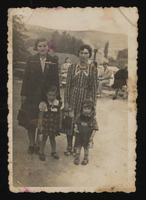Overview
- Brief Narrative
- Megillat Esther, the scroll of Esther, read on the Jewish holiday of Purim carried by Anton Spitzer when he moved to Iasi, Romania, in 1931. Shortly before he was taken away by the Nazis in 1944, Anton hid the scroll in a cellar in the Iasi ghetto. He recovered it when he returned to Iasi after the war in 1945. The family would read from this scroll on Purim in Iasi until they immigrated to Israel in 1950.
- Artwork Title
- Megillat Esther
- Date
-
creation:
before 1931
- Geography
-
use:
Iasi (Romania)
- Credit Line
- United States Holocaust Memorial Museum Collection, Gift of Nathan Shaffir
- Contributor
-
Subject:
Spitzer family
- Biography
-
Nat Shaffir was born Nathan Spitzer on December 26, 1936, in Iași, Romania to Anton and Fany (Feige, née Wax) Spitzer. Fany came from Sif (Sieu) Transylvania and was the oldest of 13 children (of which four survived the war and one died immediately afterwards). Anton had two brothers and two sisters. In 1931, Anton and Fany had moved from Transylvania to Bucium, a village near Iași, along with Anton's two brothers. The family owned a large dairy farm that supplied dairy products to the Romanian army. The Spitzers' farm prospered with many head of cattle. Fany managed the household and raised Nat and his two sisters, Sara (b. 1934) and Lili (b. 1938). In 1940, the Fascist Iron Guard visited the farm with a priest who identified the family as Jewish. They confiscated the Spitzers' farm and all the cattle and gave the family four hours to pack up their belongings. The Spitzers could take only one horse and one wagon and had to move to the Socola neighborhood of Iași. The Spitzers lived in an open ghetto and were forced to abide by the anti-Jewish legislation. They were forced to wear a yellow star and received only a small portion of bread and 10 liters of gasoline per week. Nat and his sisters were no longer allowed to attend public school. To make ends meet, Anton purchased 35 cows from a Gentile farmer, which were kept outside the city. He traded dairy products for animal feed with the local officials and sold the remaining milk, cheese, or butter to Jewish families in Iași. Adamant that her children receive an education, Fany bartered milk and cheese for private tutoring for her three children with Jewish teachers in Socola.
In early 1944, Romanian military authorities took Anton and other able-bodied men from Iași to perform forced labor laying new railroad tracks. For many months the family had no communication with Anton and had no idea if he was dead or alive. Fany and the children were left to manage the dairy business. Nat (age 8) and Sara (age 10) made butter and cheese for the local authorities. Fany continued to barter dairy goods for private education lessons for the children.
Iași fell to the Russians in July 1944; a few weeks later Anton returned to his family. By that time, most of the Spitzers' extended family, who had remained in Transylvania when it was occupied by Hungary, had been killed. Fany's father and ten of her siblings had been transported to the Auschwitz-Birkenau and Buchenwald concentration camps by Hungarian gendarmerie in complicity with the Germans. (Her mother had died years earlier in childbirth.) Her father later died of starvation in a forced labor camp. Only two of Fany's brothers, Moshe and Lazar Wax, survived to their liberation. Moshe died shortly after while on board a ship heading to a sanatorium in Sweden; Lazar recuperated in Sweden and later immigrated to the United States.
After the Communists seized power, the Spitzer children were ridiculed by their non-Jewish classmates and excluded from Communist student groups. It became evident to Anton that continued antisemitism and discrimination provided an unsafe future for his family under Soviet control. In 1947, Anton and Fany decided to leave Romania for Palestine, but their application for an exit permit was repeatedly denied. Eventually Anton bribed local officials to secure passage to Israel. The Spitzer family left Romania in March 1950 aboard a cargo ship called the Transylvania and arrived in the port of Haifa just before Passover.
While in Israel, Nat served for three years in the Israeli army. He changed his last name to Shaffir in 1959. In 1961, he immigrated to the United States and in 1969 started his own business. He married Merryl Rich of Atlanta, Georgia, in 1970. They have five children and nine grandchildren and live in Maryland, and Nat is a volunteer with the United States Holocaust Memorial Museum.
Physical Details
- Language
- Hebrew
- Classification
-
Jewish Art and Symbolism
- Category
-
Jewish ceremonial objects
- Object Type
-
Scrolls (lcsh)
- Genre/Form
- Publications.
- Physical Description
- Megillat Esther scroll composed of parchment and handwritten Hebrew text.
- Materials
- overall : paper, ink
Rights & Restrictions
- Conditions on Access
- No restrictions on access
- Conditions on Use
- No restrictions on use
Keywords & Subjects
- Topical Term
- Bible. O.T. Esther--Commentaries. Purim.
Administrative Notes
- Legal Status
- Permanent Collection
- Provenance
- The Megillat Esther was donated to the United States Holocaust Memorial Museum in 2011 by Nat Shaffir, the son of Anton Spitzer.
- Record last modified:
- 2024-09-12 07:53:04
- This page:
- https://collections.ushmm.org/search/catalog/irn43055
Download & Licensing
In-Person Research
- By Appointment
- Request 21 Days in Advance of Visit
- Plan a Research Visit
- Request to See This Object
Contact Us
Also in This Collection

Spitzer family photographs
Document
The Spitzer family photographs consist of seven prewar, wartime, and postwar photographs of the Spitzer family of Iași, Romania and their relatives. The photographs depict Anton and Fany Spitzer and their children, Sara, Nathan, and Lily as well as Fany’s sister and brother, Chana and Lazar Wax, and a cousin, Simcha Wax.



